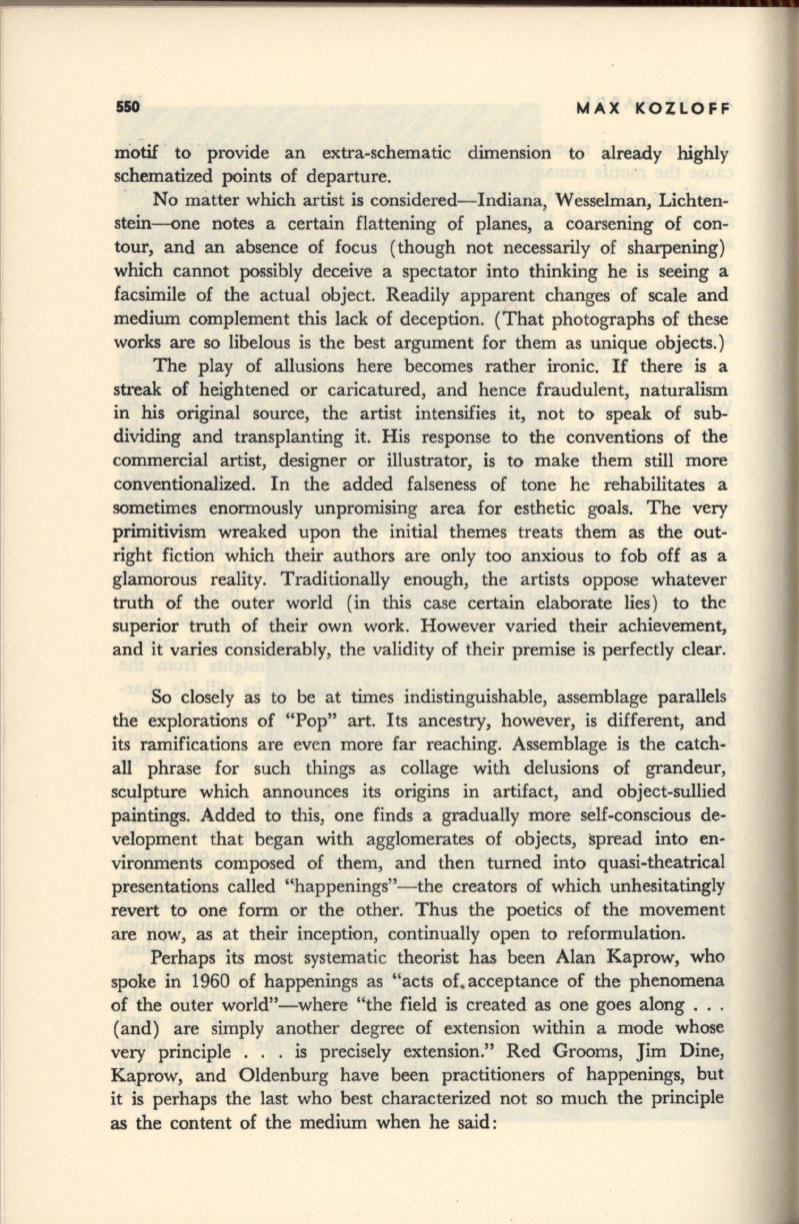

550
MAX KOZLOFF
motif to provide an extra-schematic dimension to already highly
schematized points of departure.
No matter which artist is considered- Indiana, Wesselman, Lichten–
stein-<>ne notes a certain flattening of planes, a coarsening of con–
tour, and an absence of focus (though not necessarily of sharpening)
which cannot possibly deceive a spectator into thinking he is seeing a
facsimile of the actual object. Readily apparent changes of scale and
medium complement this lack of deception. (That photographs of these
works are so libelous is the best argument for them as unique objects.)
The play of allusions here becomes rather ironic.
If
there
is
a
streak of heightened or caricatured, and hence fraudulent, naturalism
in his original source, the artist intensifies it, not to speak of sub–
dividing and transplanting it. His response to the conventions of the
commercial artist, designer or illustrator, is to make them still more
conventionalized. In the added falseness of tone he rehabilitates a
sometimes enormously unpromising area for esthetic goals. The very
primitivism wreaked upon the initial themes treats them as the out–
right fiction which their authors are only too anxious to fob off as a
glamorous reality. Traditionally enough, the artists oppose whatever
truth of the outer world (in this case certain elaborate lies) to the
superior truth of their own work. However varied their achievement,
and it varies considerably, the validity of their premise is perfectly clear.
So closely as to be at times indistinguishable, assemblage parallels
the explorations of "Pop" art. Its ancestry, however, is different, and
its ramifications are even more far reaching. Assemblage is the catch–
all phrase for such things as collage with delusions of grandeur,
sculpture which announces its origins in artifact, and object-sullied
paintings. Added to this, one finds a gradually more self-conscious de–
velopment that began with agglomerates of objects, spread into en–
vironments composed of them, and then turned into quasi-theatrical
presentations called "happenings"-the creators of which unhesitatingly
revert to one form or the other. Thus the poetics of the movement
are now, as at their inception, continually open to reformulation.
Perhaps its most systematic theorist has been Alan Kaprow, who
spoke in 1960 of happenings as "acts of. acceptance of the phenomena
of the outer world"-where "the field is created as one goes along ...
(and) are simply another degree of extension within a mode whose
very principle . . . is precisely extension." Red Grooms, Jim Dine,
Kaprow, and Oldenburg have been practitioners of happenings, but
it is perhaps the last who best characterized not so much the principle
as the content of the medium when he said:









